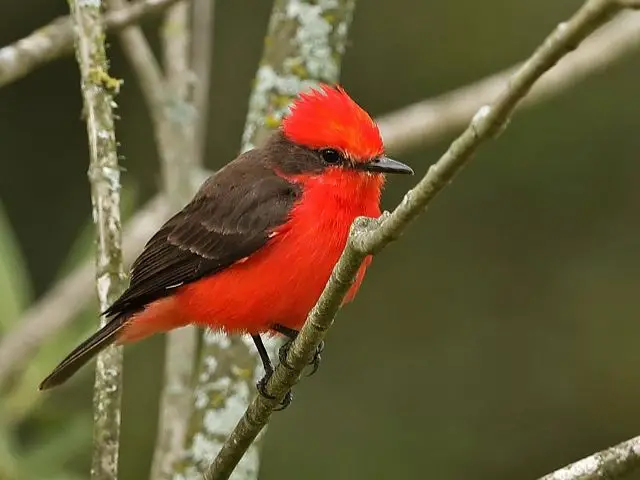Texas is second to the largest state in the United States, with a perfect climate for birds to inhabit. These birds can easily survive and live in this warm climate.
Hence...
It effortlessly became a welcoming environment for every bird looking for a new home. Texas is also known for the most bird population in the United States, and there are tons of different bird species living in it.
Exploring The Different Red Birds In Texas
Throughout the United States, birdwatchers can find these birds in various shades of red, brown, yellow, blue, and grey. Despite this, we will provide you with a more interesting overview of some of Texas' most famous "red birds."
Red is such a catchy color for everyone's eyes. Hence, I know you are reading about red bird species in Texas.
1. Northern Cardinal or Redbird
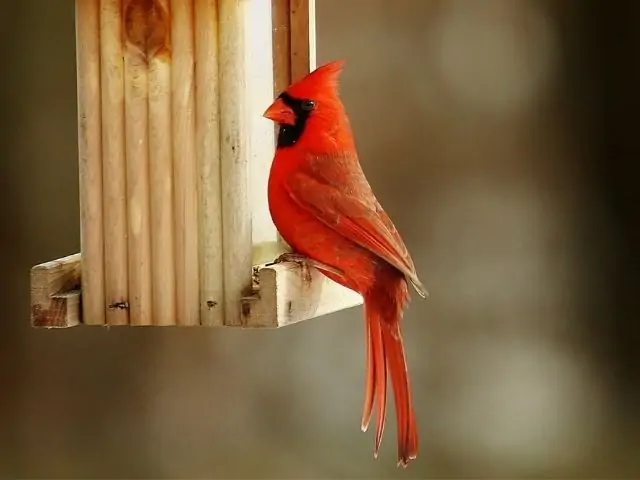
Northern Cardinals are related to some birds like the hepatic tanager, grosbeaks, and painted buntings. This species is pretty widespread of all the Texas birds on our list. Many would say that it got its name from the officials of the Roman Catholic church.
Don't worry! Native to Texas, this species thrives in deserts, shrubberies, woodland edges, and even your backyard. They can even live up to a decade. During the breeding season, you can often see Northern Cardinals in trees, bushes, and 5000 feet above the water's surface.
Safflower seed, suet, insects, and berries are among the favorite foods of these omnivores. You might see these Texas birds probing millet feeders too. Their kind could go farther North at times in response to bird feeders.
A Northern Cardinal is the most common bird you can see in Texas. You're likely to see them in backyards, just like the downy woodpecker and the scarlet tanager. This bird's presence would be impossible to miss due to its brilliant plumage that will undoubtedly captivate your attention.
A male cardinal has a red body, spherical wings, and black masks on its face. Contrarily, the female cardinal and an immature male have pale brown shades. They also have white underparts with light cerise to give color to their wings.
However, one feature that is common to each cardinal is the distinctive crest on their heads. This cardinal is a long-tailed songbird of medium size. Males are territorial and strike at intruders who invade their boundaries.
Some male cardinals unknowingly strike themselves. You might find it strange to see them doing this for the first time. Once they stare at your window, they can accidentally hit themselves.
For this reason, we advocate you close your curtains or blinds to forestall such incidents. It's our means of protecting the Northern Cardinals from harming themselves.
Besides Texas, the other states where you can encounter these birds are Minnesota, Virginia, Illinois, Indiana, North Carolina, Ohio, Kentucky.
2. Summer Tanager or Summer Redbird (Paringa Rubra)

Same as Northern cardinals, summer tanager males are well-known for their striking red plumage. They have black wings and yellow beaks that complement their red head.
In distinction, females and immature males have olive color, a greener shade on their backs and wings, with orange-yellow or yellow underparts. The female tanager can resemble male tanagers once it reaches adulthood.
Tanagers, likewise, don't have a crest; that’s why they were called soft-headed. They are collectively called solitary birds, medium-size "chunky" songbirds with large bodies and massive heads.
Isn't that cute? Male tanagers can even tirelessly sing all day during breeding time.
A summer tanager is also related to the Northern cardinal, painted bunting, and allies. These birds are hard to find because they prefer to live in high trees, wood, groves (especially oaks), hickory, forest, or pines. They are rare, like the pileated woodpecker, and can live up to 5 years.
You can see them in Pine Oak Forest every breeding season. Once the breeding is successful, there will be 3 to 5 eggs to be available for hatching. Typically, their eggs are blue-green or pale green with gray or brown spots. The hatching duration is within 11 to 12 days.
Summer tanagers are omnivorous and like eating bees (yes, they're as good as flycatchers when it comes to catching bees).
You will find spiders, grasshoppers, larvae, cicadas, bugs, flies, caterpillars, and wasps in their diet. These birds also feast on berries, safflower seeds, and other small-sized foods.
3. Vermilion Flycatcher (Pyrocephalus Obscurus)
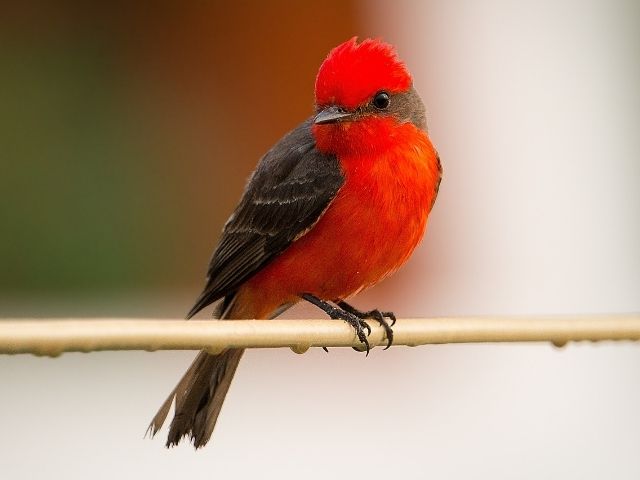
Winter, early spring, and late fall are the best seasons to see a vermilion flycatcher in the river. You can identify male vermilion flycatchers with their red bodies and black wings. They have distinct brown masks on their faces and conjointly seem like a linnet due to their beaks and tails.
Contrarily, female flycatchers and immature males have brownish shades, dark grey wings with white underparts. Fear or a sense of impending trouble make their crests appear more prominent.
Bird lovers will have no trouble finding the vermilion flycatcher in open areas near water. They are also frequent dwellers in urban settings or isolated houses. If by any chance, you are in Texas, you will see the vermillions residing in Bexar and Comal counties during the summer.
Every breeding season, you may see them in an aisle or open oak woodland located in the South Texas and Central Texas regions. Once the breeding is successful, you may expect 2 to 4 eggs available for hatching that takes up to 14 to 15 days.
The vermilions have pretty colorful eggs, white with some brown, olive, or lavender spots.
The vermilions are carnivorous and love to eat insects, suet, small invertebrates, butterflies, wasps, and cicadas. And because of the food that they eat, it is no longer necessary for them to drink water.
4. Painted Bunting (Passerina Ciris)
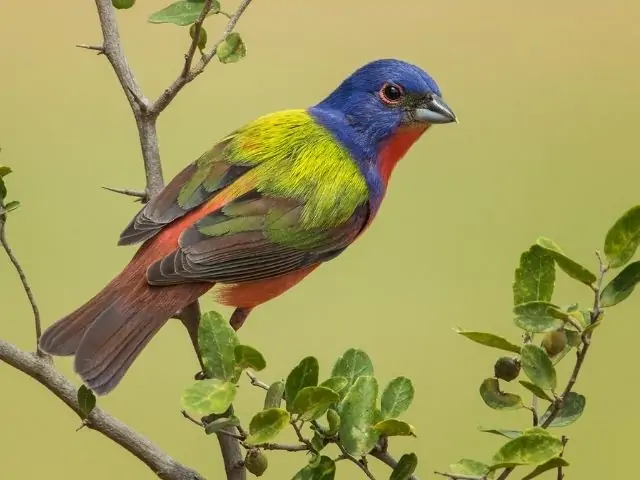
Before, painted buntings were common in Texas; however, currently, they're rare. It's a medium-sized bird that eats seeds. Its bill is stubby and thick like that of a finch.
Red bodies, green-colored backs, dark wings, and blue heads are the characteristics of a male painted bunting. Yellow-green female painted buntings have pale eyes and black or grey wings with dark tail feathers.
Painting buntings have earned a variety of names due to their beauty. As a result of its unique beauty, it is called nonpareil (without equal) in the southern U.S. The Spanish speakers call it mariposa, the butterfly.
Throughout Arkansas, Louisiana, and Oklahoma, you'll see these painted buntings at bird feeders. This bird is known for migrating at least thrice a year; to South Texas during winter and North Texas in summer.
Painted buntings are attracted to living in nearby water, shrubby areas, forests, streams, or your backyard. Who would have thought they could also live up to 10 years of age like the Northern Cardinal?
The male painted bunting is the one who chases the female painted bunting. They are monogamous once they start to mate. A week before breeding time, the male will arrive, and the female painted bunting will create a nest in 2 days that will serve as their territory.
And once the breeding is successful, expect 3 to 4 eggs to be available for hatching. Their eggs have greyish white or bluish-white eggs with red markings.
Hatching lasts 11 to 12 days. The young leave the nest 12 to 14 days later and are fed by the parents until they are fully independent. Furthermore, painted buntings are omnivores who love to eat grass, safflower seeds, insects, and small invertebrates.
Similar to humans, most female painted buntings have little to do. Incubation takes place until the eggs hatch, and the male serves as the provider and protector for the eggs during this period.
They are the ones who eat insects, parasites, lice, and mites. In addition, painted buntings spread seeds from fruit or plants they eat.
5. House Finch (Carpodacus Mexicanus)
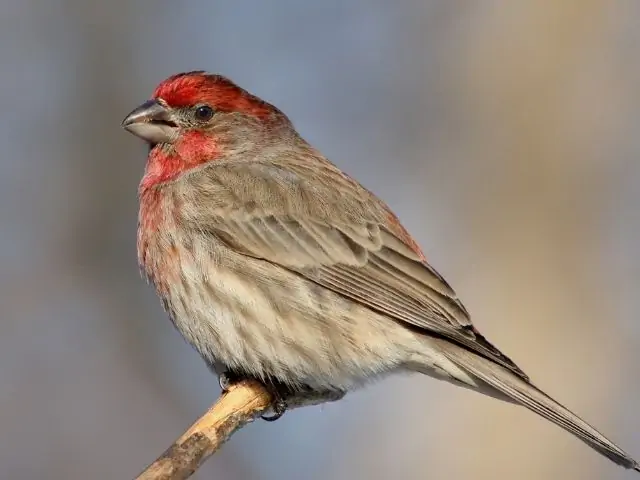
One of the Texas backyard birds that can confuse new birdwatchers is the house finch. Many people would often mistake it for either the Purple or Cassin's finch due to their similarity of having small bodies.
House finches, however, get their bright colors from the carotenoid pigments present in their diet. If you give them a simple seed diet, the bird's feathers will appear dull and yellowish.
The feathers of these house finches will turn red if they are fed fruits containing red carotenoids. Now when you see a dull-colored house finch, you pretty much know what it means.
A house finch loves to nest and forage where human homes are nearby. It is also a regular occupant of undisturbed desert habitats. Aside from their changing plumage, you will identify these finches with their conical bills and some brown streaks on their wings.
There was a significant decline in the house finch population after the epidemic of avian disease.
It poses no threat of human transmission, but other finches were also affected, like the American goldfinch, evening grosbeak, and purple finch.
Some other birds you can encounter while in Texas are the following:
- Downy woodpecker
- Pileated woodpecker
- Red-bellied woodpecker
- Ladder-backed woodpecker
- Tufted titmouse
- Purple finch
- Winter bird
- Yellow-bellied sapsucker
- Mourning dove
- Rufous hummingbird
- Lucifer hummingbird
- Costa’s hummingbird
- Ruby-throated hummingbird
- Cedar waxwing
- House sparrow
- Northern mockingbird
- Blue jay
- Carolina wren
- Wilson's warbler
Frequently Asked Questions
How to attract a painted bunting in your backyard?
It would be effortless to spot a painted bunting with all its brilliant colors. Its male has a blue head, the bottom part is red, and a combination of greenish-black wings.
You can make your home a welcoming haven for this beautiful creature by filling your backyard bird feeder with a millet seed. You can make your garden their home by also having some trees since they love perching. Some shrubs would be excellent too.
You can find more tips on how to attract a painted bunting here:
What are the top 3 common backyard birds in Texas?
The typical backyard birds you will mostly see in every bird feeder in Texas are the Northern cardinals, house finches, and the mourning doves. You can see an abundance of these birds in many different spots in Texas.
The High Island has quite a reputation for bringing glee to birdwatchers around the area. Who knows? In Central Texas, you may encounter a Nashville warbler migrating, although it's pretty rare during spring in the eastern part of the state.
Final Thoughts
We recommend you guys to take care, preserve all the birds that you may see. Create a paradise that they deserve and set up bird feeders in your backyard. Doing so will maintain their existence in the ecosystem.
Learn how to connect more effectively with these birds. The connection will always be enriching, especially for every birder, whether newbie or professional.
Now that you know about the diversity of the red birds in Texas, you will have more fun bird watching. Maybe all the new information will help you understand when to duck so that a busy warbler won't hit you on a random day.

